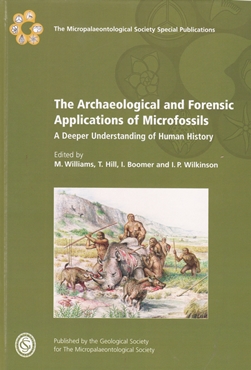 This Geological Society Publication for The Micropalaeontological Society presents 15 papers documenting the contribution of microfossils to archaeological and forensic study in relation to theory, method and interpretation. At 296 pages this volume is an engaging read with a wide range of topics and applications described by many of the leading experts in their respective disciplines. The edited volume is divided into three sections covering 1) palaeoenvironmental applications in archaeology, 2) provenancing analyses applied to archaeology, and 3) forensic applications.
This Geological Society Publication for The Micropalaeontological Society presents 15 papers documenting the contribution of microfossils to archaeological and forensic study in relation to theory, method and interpretation. At 296 pages this volume is an engaging read with a wide range of topics and applications described by many of the leading experts in their respective disciplines. The edited volume is divided into three sections covering 1) palaeoenvironmental applications in archaeology, 2) provenancing analyses applied to archaeology, and 3) forensic applications.
The papers hang together well and generally follow a chronological theme. They have been written in an accessible style that will be helpful for the many archaeologists with non-specialist knowledge of environmental science. The breadth of papers will appeal to a wide readership, as will the importance of some of the discussion topics. Although all the papers are strong, particular standouts, based on the research interests of this reviewer, was the use of foraminifera and ostracods for palaeoenvironmental and palaeoclimate reconstruction of the Lower Palaeolithic site at Boxgrove in MIS13 - c. 0.5 million years ago (Whittaker and Parfitt), the evidence presented for dry islands or islets in ‘Doggerland’ 80km off the British coast at the beginning of the Neolithic period (Geary et al.) - much later than any previous palaeocoastline models based on sea level index points, and the discussion of pollen and non-pollen palnynomorph evidence for early farming activity in Late Mesolithic pollen records (Innes and Blackford).
The range and number of authors underscores the importance of the collaborative working and interdisciplinary research that has allowed the study of microfossils to add so much to archaeology and forensics. Whether used for investigating the evolution of past landscapes, the past activities and impacts of humans within and on the landscape, unravelling the interplay of humans, landscape, vegetation and climate, or in the conviction and prosecution of criminals, this important and up to date volume will form a regular work of reference for student and specialist alike.
The papers are predominantly UK-focused, although there are excursions into the countries of the Mediterranean fringe including Italy, Macedonia and Israel. However, the findings discussed in many papers will be of interest to much more than a UK-only readership given that the Palaeolithic, Mesolithic and Neolithic transition papers discuss important data of north-west European relevance, and the methodological issues tackled by most of the papers have a more universal application.
This eclectic collection of papers in a compact volume do an admirable job of highlighting the important, although sometimes overlooked, contribution microfossil studies make to many of our fundamental questions about the past, the evolution of landscapes and the solving of felonies, including war crimes. This volume will be placed on one of my more easily-accessed bookshelves.
Reviewed by: Clive Waddington
THE APPROACHES AND FORENSIC APPLICATIONS OF MICROFOSSILS. A DEEPER UNDERSTANDING OF HUMAN HISTORY Edited by: M WILLIAMS, T HILL, I BOOMER AND I WILKINSON 2017 Published for The Micropalaeontological Society by The Geological Society. ISBN: 978-1-78620-305-2 List Price: £100 Fellows price: £60.00 W:
www.geolsoc.org.uk/TMS007